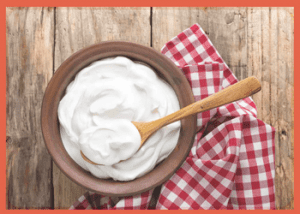We owe the tangy, creamy goodness of yogurt to Streptococcus Thermophilus and Lactobacillus Bulgaricus. These two bacterial species are essential in transforming milk into a nutrient-packed snack that we all know and love through fermentation.
They are necessary agents of the yogurt-making process; these bacteria come together to break down lactose, and produce lactic acid, thus molding yogurt’s exclusive texture and taste that sets it apart from other dairy products. Without them, making yogurt would not be possible.
Table of Contents
What are Lactobacillus Bulgaricus and Streptococcus Thermophilus?
Lactobacillus Bulgaricus and Streptococcus Thermophilus are two beneficial bacteria that help to create delicious, tangy fermented foods such as yogurt and cheese.
During the fermentation process, these microorganisms work together to convert lactose (milk sugar) into lactic acid. This conversion not only gives fermented food its unique flavor but also helps preserve it while providing numerous potential health benefits!
 Lactobacillus Bulgaricus, initially discovered in early 20th-century yogurt from Bulgaria, is a rod-shaped Gram-positive bacterium that can produce large amounts of lactic acid when exposed to lactose.
Lactobacillus Bulgaricus, initially discovered in early 20th-century yogurt from Bulgaria, is a rod-shaped Gram-positive bacterium that can produce large amounts of lactic acid when exposed to lactose.
As an obligate thermophile, it thrives best at temperatures between 40 and 45°C – but what truly differentiates this bacterium is its capacity for exopolysaccharide production.
The complex sugars produced by Λctobacillus Bulgaricus not only enhance the texture and stability of fermented foods but also make them more delicious!
Streptococcus Thermophilus is a Gram-positive, rod-shaped bacterium that ferments dairy products. Much like Lactobacillus Bulgaricus, it has the capability to turn lactose into lactic acid making it an invaluable part of food production.
In contrast with L Bulgaricus, Streptococcus Thermophilus is a facultative thermophile, allowing it to thrive in a wider range of temperatures including room temperature. Furthermore, this bacteria has the potential to make different enzymes such as proteases and lipases which can effectively break down proteins and fats found within the milk. The growth conditions of bacteria can significantly impact their physiology, metabolism, and overall viability.
| Characteristics | Lactobacillus Bulgaricus | Streptococcus Thermophilus |
|---|---|---|
| Gram staining | Positive | Positive |
| Shape | Rod-shaped | Rod-shaped |
| Fermentation temperature | Obligate thermophile | Facultative thermophile |
| Temperature range | 40-45°C | 20-45°C |
| Lactic acid production | High | High |
| Enzyme production | Exopolysaccharides | Proteases and lipases |
| Commonly used in | Yogurt, cheese | Yogurt, cheese, sour cream |
To summarize, Lactobacillus Bulgaricus and Streptococcus Thermophilus are both essential microorganisms that are integral to the fermentation of dairy products. Providing lactic acid through their ability to convert lactose into lactic acid, these bacteria help flavor and protect food from spoilage.
Lactobacillus Bulgaricus is an obligate thermophile, thriving in high temperatures while Streptococcus Thermophilus has more flexibility; it’s a facultative thermophile that can exist across a wide spectrum of heat. Both are essential to producing the likes of yogurt and cheese as well as other fermented edibles.
Difference Between Lactobacillus Bulgaricus and Streptococcus Thermophilus
One key difference is in their temperature preferences. Lactobacillus Bulgaricus is an obligate thermophile, meaning that it thrives in high-temperature environments of around 40-45°C. Streptococcus Thermophilus, on the other hand, is a facultative thermophile that can tolerate a wider range of temperatures, including mesophilic (room temperature) conditions.
 Another difference is in their enzyme production. S Thermophilus benefits are known for producing a variety of enzymes, including proteases and lipases, which help break down proteins and fats in the milk.
Another difference is in their enzyme production. S Thermophilus benefits are known for producing a variety of enzymes, including proteases and lipases, which help break down proteins and fats in the milk.
It has been shown to have potential therapeutic effects on yeast infections. L. Bulgaricus, meanwhile, is known for producing exopolysaccharides, which help improve the texture and stability of fermented foods.
Despite these differences, both bacteria share the important function of converting lactose into lactic acid, which gives yogurt its distinctive tangy flavor and helps to preserve it.
Together, Streptococcus Thermophilus and Lactobacillus Bulgaricus are essential components of the yogurt-making process and work in tandem to produce the delicious and nutritious yogurt we enjoy.
Dosage
Depending on its purpose and form, the amount of Streptococcus Thermophilus and Lactobacillus Bulgaricus in a product can differ. Generally speaking, these microorganisms are safe to ingest with no established limit for their consumption.
When using Streptococcus Thermophilus and Lactobacillus Bulgaricus in dietary supplements or functional foods, it is recommended to take 1-10 billion CFUs (colony-forming units) per day. However, everyone responds differently to probiotics so be sure to check with a healthcare professional before starting any new supplement routine.
Frequently Asked Questions
What is Lactobacillus Bulgaricus Good For?
Bulgaricus is a probiotic that can boost digestion, reduce diarrhea and soothe irritable bowel syndrome. Beneficially, Lactobacillus Bulgaricus work to maintain the normal balance of bacteria in your stomach and intestines simultaneously.
What is Streptococcus Thermophilus Good for?
Beneficial bacteria like S. thermophilus can be instrumental in aiding the breakdown of food, absorbing nutrients, and keeping harmful organisms at bay that could cause diseases.
Due to its advantageous properties, S. thermophilus is widely used for producing popular fermented dairy foods such as yogurt. Recent research indicates that the symbiotic relationship between foods that contain magnesium and probiotics, specifically Streptococcus Thermophilus, may be advantageous in terms of bettering gut health and enhancing immunity.
Where is Lactobacillus Bulgaricus and Streptococcus Thermophilus Found?
The intestinal flora, sometimes known as the gut microbiome or microorganisms, includes a beneficial bacteria named bulgaricus (L. d. bulgaricus) which is located in the digestive system.
Is Yogurt Fermented?
 Yes, yogurt is fermented! Fermentation is a process that involves the breakdown of complex organic substances into simpler ones by microorganisms such as bacteria, yeast, or fungi.
Yes, yogurt is fermented! Fermentation is a process that involves the breakdown of complex organic substances into simpler ones by microorganisms such as bacteria, yeast, or fungi.
Lactobacillus acidophilus and Lactobacillus Bulgaricus. Any Differences?
Despite their jointly shared probiotic benefits and capacity to foster gut health, there are distinctive disparities between the two bacteria with respect to metabolic pathways, fermentation profiles, and optimal habitats.
Leveraging the power of microorganisms, Acidophilus is recognized for its capacity to churn out bacteriocins in a pH-balanced environment. In contrast, Bulgaricus prefers higher temperatures and therefore requires warmth to cultivate optimally.
Conclusion
Summing up, Streptococcus Thermophilus and Lactobacillus Bulgaricus are indispensable in creating yogurt. Together these bacteria turn milk into a tasty and nutritious fermented food item. These beneficial bacteria are essential to the formation of yogurt; they break down lactose, produce lactic acid, and give it its unique flavor.
As researchers continue to investigate probiotics and gut health, these bacteria will become even more important within the food industry due to their potential for improving human well-being.
